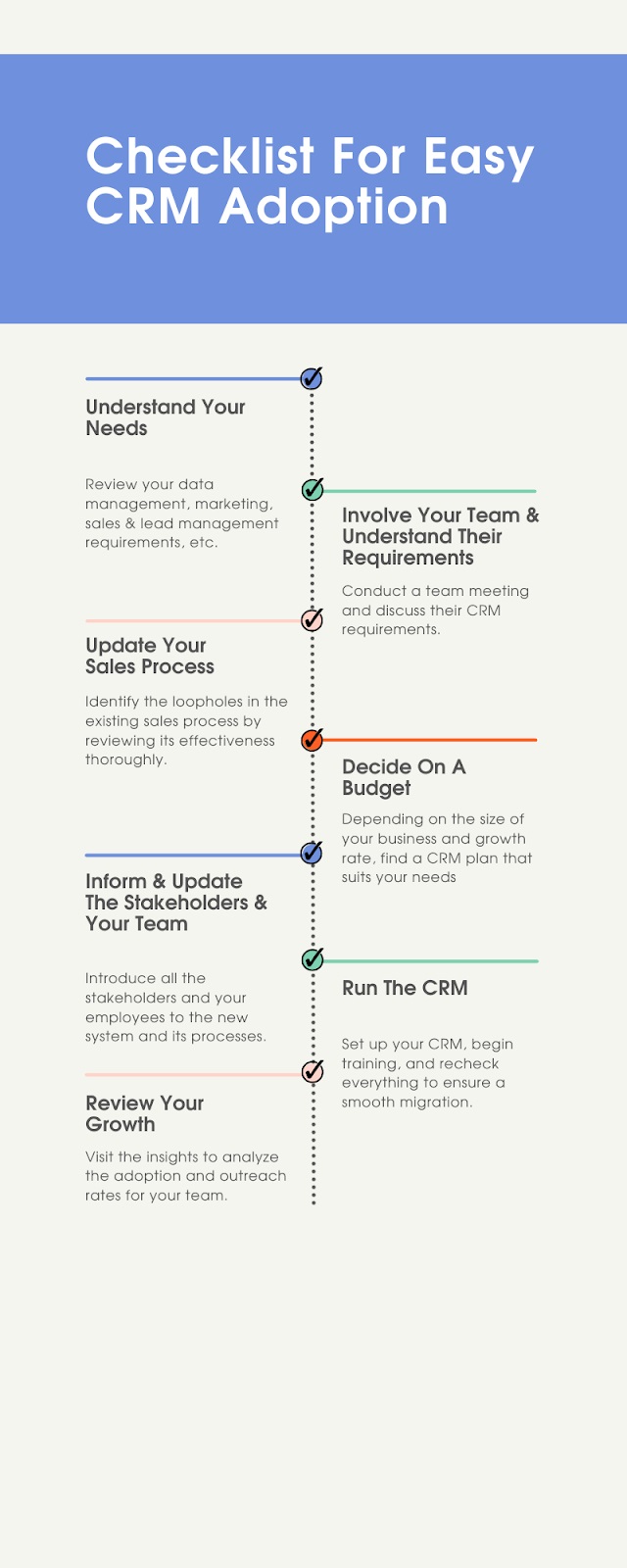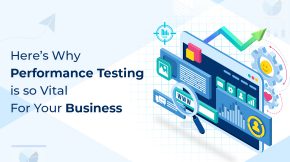The Ultimate Checklist For Easy CRM Adoption

A successful business strategy includes proper management and record memory. But having a large team and a booming business can make it slow. As a result, many companies register unintentional losses due to inefficient management. The best way to avoid these mishaps from happening is to get the best checklist for CRM Adoption
But how to find the perfect software for your needs? You’re not alone in wondering about the correct way for CRM adoption and the best software that governs all its aspects.
The ideal CRM software should have all the attributes in one place for multiple purposes — sales, marketing, tracking, etc. However, before you jump on to any available CRM, it is important to note that the transition from your regular methods and old, outdated strategies to an advanced CRM can be a difficult task. A systematic approach is essential to extract maximum benefits.
Switching to CRM software can be easy when the right plan is followed. So, go along with this easy and detailed checklist below to streamline the process of CRM adoption!
1. Understand Your Needs
An all-rounder CRM must have the following benefits:
It includes everything from storing detailed records in a central location to a strong link between databases. This improves the data integrity of your system. How would a business work without creating a track record of client engagements? Invoice generation, confirmation text, purchase history, ease of payment, etc., are the main pointers to include in your CRM system.
Every business needs the right marketing strategy. You need a tool that covers personalized campaign designs, delivery, and tracking along with batch email texts and responses.
For example, Dynamics 365 For Marketing offers an overall satisfactory experience to the business. Its features include (but aren’t limited to) fostering leads, optimizing customer services, and enhancing efficiency and productivity, making it the prime choice when it comes to finding a flexible CRM tool.
A business thrives on new leads. From lead generation to follow-up, every step is crucial. Engaging with client traffic and delivery is a key point.
- Security and Accessibility
Some important factors to consider are if the CRM allows mobile support and whether your data is protected. When these pointers are checked, you will find that the right CRM will provide data synchronization and encryption, role-based access, and wireless messaging.
This is an underrated consideration. It is essential to improve the efficiency and effectiveness of your campaigns and your team. Some aspects like document creation and search capabilities listed under this category are a part of Dynamics 365 for Marketing’s features.
2. Involve Your Team and Understand Their Requirements
This is a necessary step to collaborate with your sales, marketing, and other teams. Without the proper involvement of everyone, the scalability and performance of the business will decrease. It is easy to lose track of your success if the CRM is unable to maintain the integrity of your business.
A CRM is only useful when used right. Proper communication among team members and understanding the requirements of different departments are key factors in achieving maximum CRM adoption.
You can ask your team to rank the features of a CRM to understand the overall requisites of your business.
3. Update Your Sales Process
Take a step back and review your current sales process. It is crucial to evaluate the Key Performance Indicators (KPIs) like leads, closing dates ratio, cost per lead, or customer retention. All these can be considered unique touch-points to drive your CRM’s success in the future.
It is also imperative to find the loopholes in your current process. Go through the present strategies or tools that your business leverages. Further, conduct a thorough review and appraisal of your sales process for achieving an overall improvement in converting potential leads to regular customers.
4. Decide On A Budget
Depending on the size of your business and growth rate, find a CRM plan that suits your needs. Research the tool, its features, and client history to get the best idea. You should allocate a separate budget for training your employees.
You must also take suggestions from all the stakeholders to keep the outputs steady. For example, if your sales department lacks the expertise, more staff training will be required there.
Moreover, you must also be aware of the setup and migration costs and the expense of hampered business productivity during this process.
Microsoft Dynamics 365 CRM gives you the flexibility to choose from the various modules like Marketing, Sales, Customer Service, Field Service, and Project Service Automation. What adds the cherry on top is that you might be eligible for a discounted price, especially if you’re a non-profit organization!
5. Inform & Update The Stakeholders And Your Team
Why should your stakeholder trust the CRM approach of your business? What is in it for them? You should provide a detailed description of your new methods to all the people that will be affected by this change.
Introduce all the stakeholders and your employees to the new system and its processes. The features and benefits should be highlighted and cleared beforehand. This will keep them up-to-date and avoid doubts.
For example, let’s say you’ve adopted Dynamics 365 For Marketing. The fact that it establishes stable and steady customer relationships along with a stronghold on data should be informed to the marketing and sales department without fail. This will help them leverage the software to the best of its capabilities.
6. Run The CRM
Start by sectioning your current data in the appropriate categories and then migrate the entire data in batches to avoid overloading. This will also give you time to go through your stats once and remove duplicate files and decide the format.
Next, set up pipeline structures, lists, and fields, share the space with your team and import the users. Integrate the newly installed CRM with other applications and tools. Create user permissions, begin training, and recheck everything to ensure a smooth migration.
7. Review Your Growth
Find out whether your CRM has covered all the dynamics for marketing, sales, and engagement or not to keep your success in check. A periodic schedule for reviewing will help in assessing the use of CRM.
Dynamics 365 For Marketing, Customer Service, and Sales allow you to track your campaigns, foster leads, personalize your service for faster and efficient resolution, forecast sales to make strategic decisions, and win more deals.
Conclusion
Nothing is worse than losing prospective customers due to inefficient information-gathering tools and strategies. This is why a multidimensional platform to control and manage everything from developing, upgrading, and polishing up your customer relationships, or simply, a CRM is essential.
Finding and choosing the correct CRM can be a daunting task. But the above checklist should help you get rid of any confusion at any stage of your business. An orderly outlook, proper assessment, and team integration will result in the easy adoption of CRM for your business.
Beyond Key is one of the leading Dynamics CRM consulting companies in the world. Be it helping manufacturing companies adopt Dynamics 365 CRM or any other industry, Beyond Key can assist your business to maximize sales by correctly leveraging this technology.
Whether you’re looking for Dynamics 365 Marketing on-premise or as a cloud offering, fill out this form today to get started with the right CRM implementation strategy and empower your business with growth.
Unlock growth with our comprehensive CRM Services
Get Started













